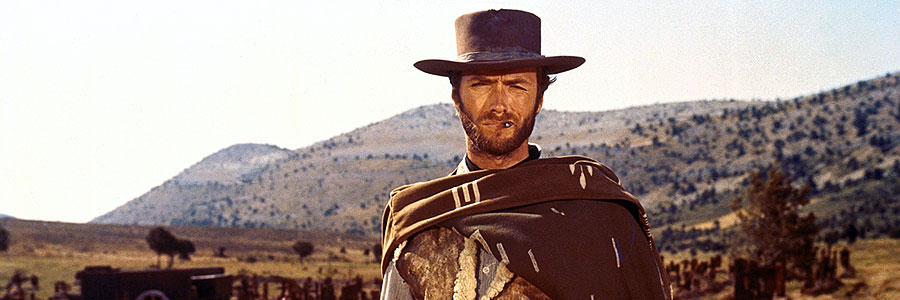
Sergio Leone & The Man with No Name
Films are frequently plagued by things they didn’t say. ‘Play it again, Sam’ and ‘A man’s gotta do what a man’s gotta do’ were never spoken in their respective films. Similarly, the Man with No Name, who features in the first three Leone Westerns – A Fistful Of Dollars (1964), For A Few Dollars More (1965) and The Good, The Bad And The Ugly (1966) – always had a name: Joe, Manco and Blondie respectively.
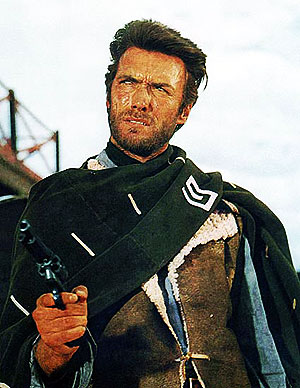 Fistful Of Dollars, dir. Sergio Leone, 1964
Fistful Of Dollars, dir. Sergio Leone, 1964The Man with No Name was an invention of the publicity department that oversaw the US marketing. Due to an unresolved rights issue with Akira Kurosawa (A Fistful Of Dollars was basically a straightforward rip off of Kurosawa’s Yojimbo), Leone had made all three films without yet having one of them released in the US much to Clint Eastwood’s chagrin. Eastwood was still at this stage more famous for the household name Rowdy Yates from the TV show Rawhide. However, it meant the films, financed by their European and particularly Italian success, would arrive in the US as a readymade trilogy, a fait accompli repositioning of the Western genre and reinventing of the character of the American hero.
As such it seemed natural to give the Eastwood character a protean identity. He was at once no one and everyone. He was simply the man who comes to town. In The High Plains Drifter (1973) Eastwood would replay his most Leone-inspired character as simply the Stranger; Camus with a six shooter. American audiences saw the three films in the space of one year. 1967 saw the release of Fistful Of Dollars (it was released in Italy in 1964) followed a few months later by For A Few Dollars More and finally The Good, The Bad And The Ugly in December. Audiences would also have seen them as double or triple bills – Eastwood’s characters would meld into essentially one character: the Man with No Name.
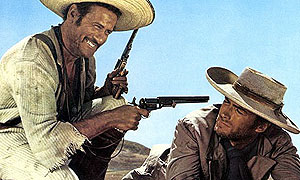 The Good, The Bad And The Ugly, dir. Sergio Leone, 1966
The Good, The Bad And The Ugly, dir. Sergio Leone, 1966And yet this namelessness is part of the essential fantasy and can be seen as justified in the films themselves. Like Quentin Tarantino, Leone had the fantasy of creating a universe in which all his films could live. There is a doubling as a troupe of actors is used again and again – Gian Maria Volante, Lee Van Cleef, Mario Brega and Aldo Sambrell among others – sometimes in wildly different roles, usually in repetitions, echoes, reflections. Eastwood’s character could be said to be the same, who’s simply given nicknames by other people. He doesn’t introduce himself as Joe, the barman calls him that, presumably because it’s a generic American English name. However, in the second film, Manco refers specifically to him being left handed (it means one handed in Spanish) and he in fact only uses his left hand throughout the film, except to shoot. This is also a trick to get the better of his enemies and give him the edge when it comes to the draw. Still, Manco wears the same poncho and smokes the same filthy cheroots and is essentially the same terse Eastwood performance as Joe was.
Blondie’s characterised as Blondie by the diametrically opposed (in terms of hair and volubility) Tuco. Angel Eyes also refers to Eastwood’s character as ‘blond-haired angel’. Blondie’s goodness is superficial: his self-interest and sadism has a cooler appearance than that of either Tuco or Angel Eyes, but he isn’t morally better. Identity is almost entirely to do with broad categories, as suggested by the title of the film, and these categories are to do with costume and appearance. When Blondie finds and dons his poncho towards the end of the film, the suggestion is that he’s become Joe and will ride off through the end credits of The Good, The Bad And The Ugly and loop back into the opening sequence of A Fistful Of Dollars.
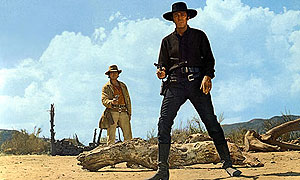 Once Upon A Time In The West, dir. Sergio Leone, 1968
Once Upon A Time In The West, dir. Sergio Leone, 1968Leone intended to carry on with Eastwood in Once Upon A Time In The West (1968) but Eastwood had had enough. A secondary idea was to have Tuco, Angel Eyes and Blondie play the waiting gunmen who Harmonica disposes of at the beginning of the film. Again, Eastwood saw very little in it for him or for his character in having him gunned down as a bit part in the opening minutes of a Leone masterpiece. The American actor’s instincts were good and the film benefits from stepping away from the earlier trilogy.
Whereas the Man with No Name rarely had a backstory, Harmonica was all backstory. His enigmatic granite faced glint-eyed persona is the lurking absence. He’s nothing but his trauma, which is only gradually revealed. When we finally see him as a boy we might notice that he’s wearing a similar if not the identical costume as he is as a grown man. Harmonica is the trauma made man. He’s done nothing in the intervening time. Colonel Mortimer will also have revenge, but his revenge is not defining. He’s his own man, who will do this then do something else. Instead, Harmonica will only do this. He will reject Jill’s (Claudia Cardinale) implicit offer of marriage and domesticity and will go into the desert where he will disappear, because he’s a ghost. He has no libido as such, just a wrong to right.
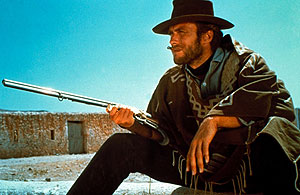 For A Few Dollars More, dir. Sergio Leone, 1965
For A Few Dollars More, dir. Sergio Leone, 1965Harmonica is still essentially a maturing of the Man with No Name and this maturation will continue in Sean in Duck You Sucker! (1971) and Noodles in Once Upon A Time In America (1984). In contradistinction to the Man with No Name who represents an awakening from the nightmare of history, a liberating from the past and trauma, Harmonica, Sean and Noodles are not simply haunted by the past as dominated by it. For both Sean and Noodles, the trauma of the past is to do with betrayal and both characters are implicated and ridden by guilt. Harmonica is still in the realms of fantasy. He has the innocence of the pure revenger. Some men did this to him so he hunts them down. Noodles and Sean are active participants in their own ‘wrong beginnings’ to paraphrase Philip Larkin and lumbered with regret and also ignorance. They don’t quite know what went wrong.
Meanwhile, the Man with No Name was consigned to comedy. Leone produced, wrote and partly directed the Terrence Hill and Henry Fonda comedy My Name is Nobody in 1973. The film follows a famous gunslinger Beauregard (Fonda) who is badgered by Nobody (Hill), a young man who has taken on the name because he hears as a child that nobody is faster than Beauregard. Hill had already made a name for himself, first as Terrence Hill rather than the Venetian born Mario Girotti and as the star of the popular Trinity series, playing opposite Bud Spencer. Hill to this day keeps his anglicised nom de art. For Leone, who released his first Western under the moniker Bob Robertson, namelessness and pseudonyms were to be used and then discarded as he moved on to ever more ambitious projects.
—–
Part 1: The Game of Death
Part 2: Sergio Leone & Women
Part 3: The Man with No Name

John Bleasdale
John Bleasdale is a writer based in Italy. He has published on films at various internet sites and his writing can be found, along with blog posts, collected at johnbleasdale.com.
He has also contributed chapters to the American Hollywood and American Independent volumes of the World Directory of Cinema: (Intellect), Terrence Malick: Films and Philosophy (Continuum) and World Film Locations: Venice (Intellect). You can also follow him on Twitter @drjonty.
© 2022 STATIC MASS EMPORIUM . All Rights Reserved. Powered by METATEMPUS | creative.timeless.personal. | DISCLAIMER, TERMS & CONDITIONS
HOME | ABOUT | CONTACT | TWITTER | GOOGLE+ | FACEBOOK | TUMBLR | YOUTUBE | RSS FEED
CINEMA REVIEWS | BLU-RAY & DVD | THE EMPORIUM | DOCUMENTARIES | WORLD CINEMA | CULT MOVIES | INDIAN CINEMA | EARLY CINEMA
MOVIE CLASSICS | DECONSTRUCTING CINEMA | SOUNDTRACKS | INTERVIEWS | THE DIRECTOR’S CHAIR | JAPANESE CINEMA





